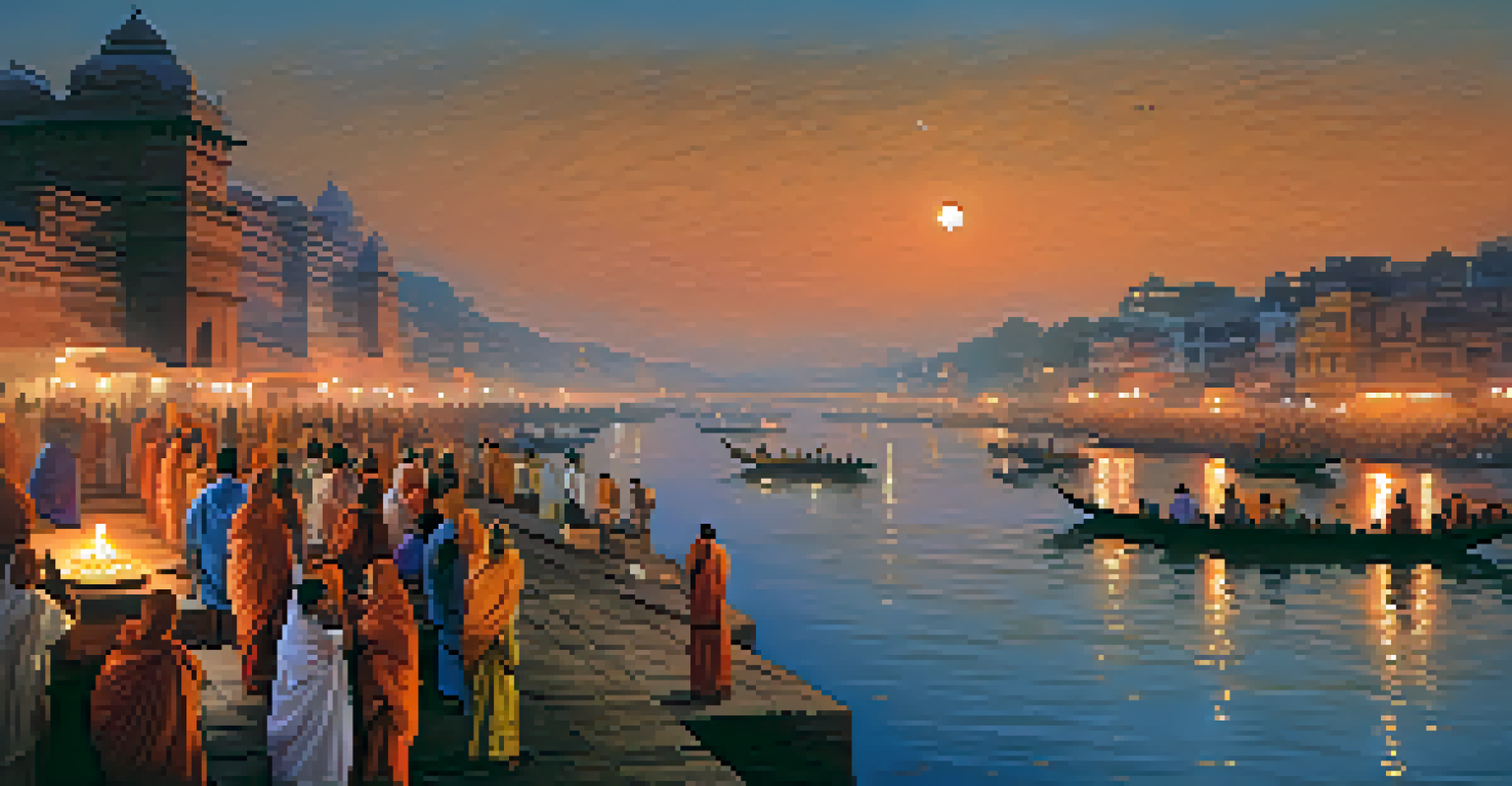Exploring Sacred Pilgrimage Sites Around the World

The Significance of Pilgrimage in Various Cultures
Pilgrimage is a practice found in many cultures, often serving as a journey of spiritual significance. These journeys can bring individuals closer to their faith, offering a chance for reflection and personal growth. Beyond spirituality, they often foster a sense of community among travelers, uniting people with shared beliefs and experiences.
The journey of a thousand miles begins with one step.
From the Hajj in Mecca to the Camino de Santiago in Spain, each pilgrimage has its unique rituals and customs. These practices not only deepen one's faith but also connect individuals to their cultural heritage. Pilgrimages often represent a quest for meaning, making them a powerful aspect of human experience.
Understanding the significance of pilgrimage helps us appreciate the diverse ways people seek spiritual fulfillment. It serves as a reminder that, regardless of our backgrounds, the desire for connection to something greater is a universal theme.
Mecca: The Heart of Islam's Pilgrimage
Mecca, the birthplace of the Prophet Muhammad, is home to the Kaaba, the most sacred site in Islam. Each year, millions of Muslims from around the globe embark on the Hajj pilgrimage, fulfilling one of the Five Pillars of Islam. This spiritual journey is not only a physical challenge but also a deeply emotional experience of devotion and unity.

The rituals performed during Hajj, such as circling the Kaaba and standing at Arafat, hold profound significance. They symbolize the core tenets of Islam, including humility, equality, and submission to God. Each step taken during this pilgrimage is steeped in tradition and meaning, fostering a deep sense of connection to faith.
Pilgrimage: A Universal Journey
Pilgrimage serves as a powerful reminder of our shared humanity and the diverse ways people seek spiritual connection.
For many, the opportunity to visit Mecca is a lifelong dream, representing a culmination of faith and dedication. The atmosphere during Hajj is electric, filled with prayers and praises, illustrating the power of collective spirituality.
The Camino de Santiago: A Journey Through Spain
The Camino de Santiago, or the Way of St. James, is a network of pilgrimage routes leading to Santiago de Compostela in Spain. This journey has captivated travelers for centuries, combining scenic beauty with a profound spiritual experience. Pilgrims often embark on this trek for various reasons, including spiritual growth, personal reflection, or simply the love of hiking.
The pilgrimage is not a journey to the end of the world, but a journey to the end of oneself.
Walking the Camino allows individuals to disconnect from daily life and connect with nature and themselves. Along the way, pilgrims encounter charming villages, historic churches, and fellow travelers, creating a unique sense of camaraderie. Each step taken is a chance to reflect on life’s journey and embrace the present moment.
The Camino is more than just a physical trek; it's a transformative experience. Many return home with new perspectives, friendships, and a renewed sense of purpose, making it a truly enriching pilgrimage.
Varanasi: A Spiritual Epicenter in India
Varanasi, one of the oldest inhabited cities in the world, is considered the spiritual heart of India. The Ganges River, flowing through the city, is revered as a sacred body of water, attracting millions of pilgrims who come to cleanse their sins and seek salvation. The vibrant ghats along the river are bustling with activity, filled with rituals, prayers, and ceremonies.
During a visit to Varanasi, one can witness the mesmerizing Ganga Aarti, a nightly ritual that honors the river. This experience highlights the deep connection between spirituality and nature in Hindu culture. Pilgrims often describe the atmosphere as both tranquil and exhilarating, a blend of devotion and sensory overload.
Nature Enhances Pilgrimage Experience
The stunning natural backdrops of sacred sites play a vital role in deepening the spiritual significance of the pilgrimage.
In Varanasi, the act of pilgrimage is not just about reaching a destination; it’s about immersing oneself in the spiritual tapestry of India. Each visit offers a unique perspective on life, death, and rebirth, encapsulating the essence of Hindu beliefs.
Jerusalem: A City of Shared Faiths
Jerusalem holds profound significance for Judaism, Christianity, and Islam, making it a unique pilgrimage destination. The city's rich history is woven with sacred sites, such as the Western Wall, the Church of the Holy Sepulchre, and the Al-Aqsa Mosque. Each of these locations tells a story of faith and devotion, drawing millions of pilgrims each year.
Walking through the streets of Jerusalem, one can feel the weight of history and spirituality in the air. The diversity of pilgrims adds to the city's vibrant atmosphere, as people from different backgrounds come together to express their beliefs. This convergence showcases the beauty of shared faith amidst differing traditions.
For many, a pilgrimage to Jerusalem is a journey of a lifetime. It offers a chance to deepen one's faith, learn about the rich tapestry of religious history, and experience the profound sense of unity that transcends borders.
Mount Kailash: A Sacred Peak in Tibet
Mount Kailash is considered sacred in Hinduism, Buddhism, Jainism, and Bon, making it a revered pilgrimage site for many. Located in Tibet, this majestic peak is believed to be the abode of Lord Shiva, attracting devotees who seek spiritual enlightenment. The trek around Mount Kailash, known as kora, is a challenging yet fulfilling journey filled with breathtaking landscapes.
Pilgrims believe that completing the kora can wash away sins and bring good fortune. The journey is as much about the physical challenge as it is about the spiritual experience, encouraging deep introspection and connection to the divine. Each turn of the trail offers stunning views, serving as a reminder of the beauty of nature and its connection to spirituality.
Cultural Significance of Pilgrimages
From Mecca to Varanasi, each pilgrimage reflects unique rituals that connect individuals to their faith and cultural heritage.
Mount Kailash represents the intersection of faith and adventure, inviting pilgrims to explore both the outer world and their inner selves. It’s a testament to the enduring power of belief and the lengths individuals will go to seek spiritual fulfillment.
The Role of Nature in Pilgrimage Experiences
Many sacred pilgrimage sites are set against stunning natural backdrops, enhancing the spiritual journey. Nature often serves as a source of inspiration and reflection, creating a deeper connection to the divine. Whether it’s the serene mountains of Tibet or the lush paths of the Camino, the environment plays a vital role in shaping the pilgrimage experience.
Pilgrims frequently report feeling a sense of peace and clarity when surrounded by nature. The tranquility of these settings provides an opportunity to contemplate life, faith, and purpose. The rhythmic sound of footsteps on a forest trail or the gentle flow of a river can become meditative, allowing for moments of deep connection.

Ultimately, nature amplifies the essence of pilgrimage, reminding us of our place in the world. It encourages us to slow down, observe, and appreciate the journey, both literally and metaphorically.
Conclusion: The Enduring Power of Pilgrimage
Exploring sacred pilgrimage sites around the world reveals the enduring power of faith and the human spirit. These journeys, whether they are physical or metaphorical, connect us to something greater than ourselves. They remind us of our shared humanity and the diverse ways people seek meaning and connection.
As we travel to these sacred spaces, we are invited to reflect on our own beliefs and values. The stories of those who have walked before us enrich our understanding of the world and inspire us to embark on our own journeys, both literal and spiritual.
In a world that often feels disconnected, pilgrimage serves as a powerful reminder that the quest for meaning is universal. Whether we walk the ancient paths of Santiago or stand by the Ganges, each step taken in faith can lead to profound transformation.